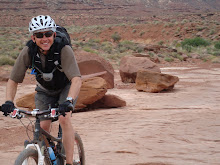This is the beginning of the St Kevin’s segment of the race. It is double-track/jeep road with several erosion gulleys, a couple trickles of stream water to cross, jumbled boulders, and 3 short pitches with a grade in the 20 – 23% range.
The steep and rocky bit is only 1.5 miles long, but many racers will see their ride cut short in this section. You need to be able to get in a small gear and just spin, avoiding the racers who can’t ride this pitch and end up dismounting suddenly in front of you, either in a planned dismount or an Arte Johnson (if you don’t remember “Laugh-In,” you are too young to read this blog) slow motion tip-over dismount because they couldn’t unclip from their pedals in time to avoid falling over.
You climb about 1,000 feet in the 5 mile St. Kevin’s segment. There are a few more loose, rocky sections, and a very dangerous descent on a rutted double-track before crossing a forest service road and making a hard right to a section of really fun and really fast double-track that all too quickly spits you out on the Turquoise Lake paved road. Congratulations – you made it through the first 10 miles.
Only 92 more miles to ride!
I'll cover the next segment of the course (Turquoise Lake Road to Sugarloaf Pass/The Powerline) in a later post.
What should I wear?
Deciding what to wear on race day is more nerve-wracking than picking out a dress for your senior prom – bad choices may not be memorialized forever in high school yearbook photos, but I promise you’ll never make the same mistake twice – with or without photographic evidence of your “What was I thinking?” moment.
You need to accept the fact that you will be shivering and your fingers and toes will be completely frozen for the first 5 miles. If you have on enough clothes to be warm at the start, you’ll be miserable by the time you hit the base of St Kevin’s. If you stop there to strip off a jacket, you’ll get mixed up with the crowd of racers who can’t ride that section without dabbing (putting a foot down) or flat-out walking. You could easily lose 5 minutes, and in a worst case scenario, maybe as much as 15 minutes, if you get tangled up with that crowd.
What works for me is:
Long fingered MTB gloves, but not “warm” gloves; I like Fox Incline gloves for this segment.
I'll cover the next segment of the course (Turquoise Lake Road to Sugarloaf Pass/The Powerline) in a later post.
What should I wear?
Deciding what to wear on race day is more nerve-wracking than picking out a dress for your senior prom – bad choices may not be memorialized forever in high school yearbook photos, but I promise you’ll never make the same mistake twice – with or without photographic evidence of your “What was I thinking?” moment.
You need to accept the fact that you will be shivering and your fingers and toes will be completely frozen for the first 5 miles. If you have on enough clothes to be warm at the start, you’ll be miserable by the time you hit the base of St Kevin’s. If you stop there to strip off a jacket, you’ll get mixed up with the crowd of racers who can’t ride that section without dabbing (putting a foot down) or flat-out walking. You could easily lose 5 minutes, and in a worst case scenario, maybe as much as 15 minutes, if you get tangled up with that crowd.
What works for me is:
Long fingered MTB gloves, but not “warm” gloves; I like Fox Incline gloves for this segment.

A short sleeved jersey, with arm warmers. As you heat up, you can roll down the arm warmers.
A windproof vest. I just started wearing vests three seasons ago, and I can’t believe I was so slow to see the light. They are the best layering tool – ever!! They keep your core protected; combined with arm warmers they give you tons of temperature regulating options.

Knee warmers. For me, full leg warmers are often too much, but I wear knee warmers if it is less than 60 degrees.
Half shoe covers. If it is even a little bit damp, I wear my “Calientoes.” My feet still get cold, but it is bearable.

I also wear a light skullcap under my helmet.
Of course, if it is actually raining at the start, all bets are off. There are no warm rains in Leadville, and I honestly don’t know if I could bring myself to start the race in the rain. The chances of me being hypothermic by the time I hit the Turquoise Lake pavement are very high.
So I'm counting on you all to keep thinking "warm and dry" thoughts.











